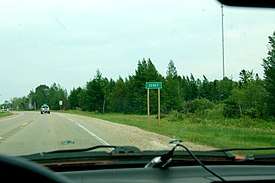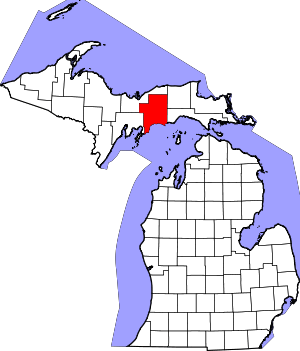Seney, Michigan
Seney is an unincorporated community in Schoolcraft County in the Upper Peninsula of Michigan, United States. The historic community began as a railroad stop in 1881. Soon after, logging companies moved into the area to lumber the white pine forests in the surrounding region. Seney soon grew to over 3,000 people. During this time, the town gained a reputation for being rowdy and dangerous due its boom economy and numerous saloons. By the end of the nineteenth century, the forests of pine in the surrounding region were depleted and the lumber companies left, shrinking the town considerably. It currently has less than 200 people.
Seney, Michigan | |
|---|---|
 Sign at the western edge of Seney | |
 Seney Location within the state of Michigan | |
| Coordinates: 46°20′44″N 85°56′44″W[1] | |
| Country | United States |
| State | Michigan |
| County | Schoolcraft |
| Township | Seney |
| Elevation | 735 ft (224 m) |
| Time zone | UTC-5 (Eastern (EST)) |
| • Summer (DST) | UTC-4 (EDT) |
| ZIP code(s) | 49883 |
| Area code(s) | 906 |
| GNIS feature ID | 1619567[1] |
Today, the town is noted as a gateway to the region's recreation and tourism. It is located on the outskirts of the Seney National Wildlife Refuge, administered by the U.S. Fish and Wildlife Service, and is a through way to the eastern end of the Pictured Rocks National Lakeshore. Seney is also the terminus of the hiking trail known as the Fox River Pathway (which connects with the North Country Trail).
The town was featured in Ernest Hemingway's short story "Big Two-Hearted River" which Hemingway based on a visit to the town that he made in his youth. Leon Czolgosz, the man who assassinated President William Mckinley, was a visitor to the town for a period of time during the boom years when he worked on the local railroad.
Seney is located on the eastern end of the Seney Stretch. A "Boot Hill" cemetery is located outside of town. The community is located in Seney Township, Michigan.
Incredible Seney (1953) is a nonfiction book about Seney's historic boom years written by Lewis Reimann.
External links
- Official website for the Seney National Wildlife Refuge Last updated: September 16, 2012
- Upper Peninsula Online, Seney Information
- Wood, Vivian. "A Little History of Seney, Michigan in the Upper Peninsula". Exploring the North: The Upper Peninsula and Northern Wisconsin Traveler. Retrieved March 24, 2013.
- Jobst, Jack (November–December 1990). "Hemingway in Seney". Historical Society of Michigan. Retrieved March 24, 2013 – via Clarke Historical Library.
